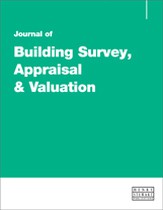Are building regulations increasing damp, decay and causing health issues to occupants of traditional and historic buildings?
Abstract
There are industry concerns that changes to Approved Document L of the Building Regulations 2010 that came into force in England on 15th June, 2022, have little regard for the thermal improvement of traditional and historic buildings. This uplift in the regulations is a stepping stone approach by government to achieve net zero carbon by 2050. We can expect more government changes to the Building Regulations in 2025 to achieve further carbon emission improvements of up to 80 per cent. This paper posits that, without proper guidance in the Approved Documents, we will see ever-increasing dampness and deterioration in our traditional and historic buildings built with solid walls, causing health issues for those who occupy them.
The full article is available to subscribers to the journal.
Author's Biography
Anthony Gwynne MSc (Dist), MRICS, IFireE, IHBC has been in local authority building control for 34 years as a practising surveyor, team leader and manager. He has been a chartered building surveyor for over 30 years and a fire engineer for over 20 years. He obtained a Master’s degree with a distinction in sustainable building conservation from Cardiff University in 2020. During his career he has dealt with a wide range of building types including dwellings, multi-storey residential, offices, shops and commercial, assembly, recreational, industrial, historic buildings and non-standard forms of construction such as straw bale houses. He is now registered with the Building Safety Regulator as Class 3 Specialist dealing with non-standard forms of construction, and Class 4 as a technical manager. Anthony has specialised in traditional buildings since he began his career as a conservation specialist working for Cadw and English Heritage on preservation of national monuments. He has published a textbook on the Building Regulations and is currently writing a second book for Wiley Blackwell. Additionally, he is working with Historic England on guidance for the thermal improvement of traditional buildings built with solid walls. He has recently written articles for ICOMOS, the First and Second international Conference on Moisture in Buildings (2022 and 2023). He also serves as a technical panel member for the Institute of Historic Building Conservation (IHBC).
Citation
Gwynne, Anthony (2025, June 1). Are building regulations increasing damp, decay and causing health issues to occupants of traditional and historic buildings?. In the Journal of Building Survey, Appraisal & Valuation, Volume 14, Issue 1. https://doi.org/10.69554/TBBU3618.Publications LLP
